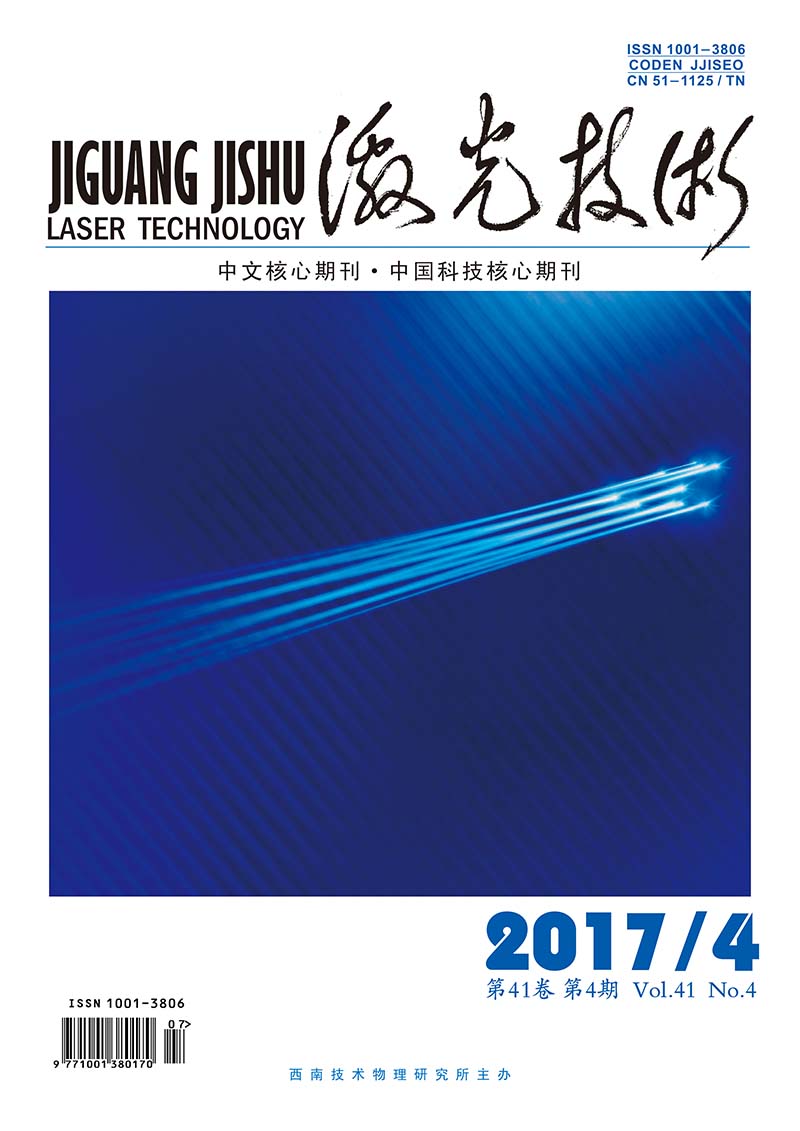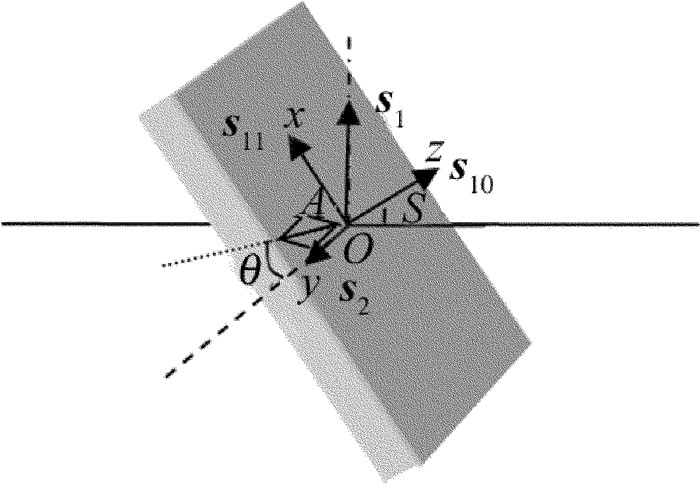HTML
-
Rochon棱镜发明于1783年,通常由两块光轴相互垂直的冰洲石晶体直角棱镜胶合而成[1-2],由于冰洲石晶体具有光学性能稳定、双折射率大[3-5]、透射光谱范围宽等特点[6-7],所以以其为原料制成的Rochon棱镜具有消光比高(优于10-5)、透射比大(大于87%)[8-9]、抗损伤域值高等一系列优点,是当前激光应用技术中广泛使用的偏光分束棱镜[10-12]。Rochon棱镜可以正向使用,也可以反向使用,但反向使用时,消光比会下降,对于会聚光束或发散光束,锥光干涉会引起反向消光比的下降,但对于平行光束,反向通过Rochon棱镜后,实验中发现传播方向不变的一束光的消光比仍然比正向应用时低。作者对此进行了系统的理论分析,给出了这一现象的一种合理解释,并通过实验对理论分析结果进行了验证,本文中的研究成果可为Rochon棱镜的设计制作和正确使用提供必要的参考。
-
Rochon棱镜正向和反向应用时,光在棱镜中传播的光路分别如图 1a和图 1b所示。图中S为棱镜的结构角,i为垂直于棱镜端面的入射光线,h为胶合层的厚度。对于正向使用的Rochon棱镜,由图 1a可知,入射自然光在棱镜的第一部分及胶合层中传播时,并不起偏,当到达胶合层与棱镜第二部分的分界面时才分成o光和e光;对于反向使用的Rochon棱镜,入射自然光进入棱镜的第二部分后,便被分成o光和e光,但二者传播方向一致,在棱镜第二部分和胶合层界面处,o光和e光传播方向分离,经棱镜第一部分出射。实验表明,棱镜反向使用时,o光的消光性能显著下降。
为了解释棱镜反向使用时o光消光比下降的原因,先对胶合层进行分析。由于胶合层采用的胶合剂为各向同性介质,在存在应力的情况下由于光弹效应会变为各向异性介质[13-14],胶合层固化后,胶合层内任意一点A的受力模型可用图 2表示。
图 2中建立直角坐标系O-xyz,Ox和Oy轴位于胶合层所在的平面内,坐标原点O在A点上。A点在x, y, z方向受到的应力分别用s11, s2, s10表示,s1和s2分别为垂直于o光传播方向的最大主应力和最小主应力,其中s2为s11和s10的矢量和。由图 1可知,胶合层法线与光传播方向的夹角与棱镜结构角S相等,即s10与光的传播方向的夹角为S(如图 2所示),所以s1=s10sinS+s11cosS。另外假设胶合层内所有点的受力情况都与A点相同,由两向应力-光学定律得[15]:
式中,Rt为光矢量方向平行于s1和s2的两束线偏振光分量通过胶合层时产生的光程差,Rt为t的函数,t为沿光线传播方向材料的有效厚度,满足$ t = \frac{h}{{\cos S}} $,k为与胶合剂材料有关的应力-光学常数。所以,胶合层对于入射光来讲,相当于通过延迟量为$ \Delta = {R_t}\frac{{2{\rm{ \mathsf{ π} }}}}{\lambda } $的相位延迟器,假设s2与o光光矢量之间的夹角为θ,Rochon棱镜反向使用时,满足[16]:
式中, Ex表示光矢量在x方向上的分量,Ey表示光矢量在y方向上的分量。由此可见,线偏振光经胶合层等效的相位延迟器后,变为椭圆偏振光。上面的理论分析同样适用于e光,即o光和e光经胶合层后都变成了椭圆偏振光。由光在晶体中传播的知识可知[17],在单轴晶体中,传播的e光只能是平面偏振光,所以Rochon棱镜无论正向使用还是反向使用,e光都具有较高的消光比。对于o光,棱镜正向使用时,从胶合层出射的光要经过棱镜的第二部分,而在棱镜的第二部分中,晶体光轴与光的传播方向不一致,因此o光只能是平面偏振光,所以消光比较高,而反向使用时,从胶合层出射的光要经过棱镜的第一部分,但在棱镜的第一部分中,晶体光轴与光的传播方向一致,因此o光可以是平面偏振光、椭圆偏振光或圆偏振光,所以从胶合层出射的椭圆偏振光会直接经棱镜第一部分出射,即出射o光为椭圆偏振光,导致消光比会降低。
-
Rochon棱镜o光消光比测试及偏振态的检测光路如图 3所示。光源采用He-Ne激光器,由激光器发出的光经扩束透镜和准直透镜后,变为准直光束,垂直与入射Rochon棱镜,测试消光比时,不加入λ/4波片,o光直接进入检偏器,然后通过衰减器进入CCD探测器,检偏器采用优质格兰-泰勒棱镜,其消光比优于10-7,利用计算机对CCD采集到的数据进行分析。检测o光偏振态时,光路中加入λ/4波片,旋转λ/4波片,使其快轴与消光比测试时检测到的光强最大(最小)方位一致,再旋转检偏器,测量消光比,实验结果如表 1所示。
forward reverse extinction ratio (collimating beam) 1.14×10-5 without λ/4 wave-plate with λ/4 wave-plate 2.93×10-3 5.72×10-5 Table 1. Parameters of extinction and polarization detection
由表 1可知,在准直光束照射下,Rochon棱镜反向消光比远小于正向,但加入λ/4波片后,反向消光比增大,由此可见,棱镜反向使用时,出射光中含有椭圆偏振光的成分,这与理论分析的一致,但是与正向使用的棱镜相比较,消光比仍然较低,其原因是上面分析时,将胶合层受力后看成单轴晶体,各点受力情况均相同所致。
-
通过对Rochon棱镜胶合层受到的应力进行分析,得出由于胶合层光弹效应的影响,平面偏振光经过后会变成椭圆偏振光,结合晶体光学的相关知识,从理论上解释了Rochon棱镜反向使用时,o光消光比下降的原因,并设计实验,对理论分析的结果进行了验证。本文中相关的理论和实验研究成果可为Rochon棱镜的设计和应用提供有益的参考。

 Map
Map







 DownLoad:
DownLoad:

